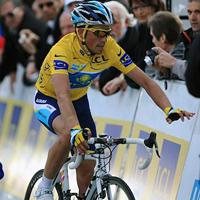
Recently on Cyclingnews.com |
March 25, 2009
Fuelling by numbers
When you get your big ride fuelling wrong, you experience a hunger flat, big time, and enter a whole world of heavy-legged, pit-in-the-stomach riding. We all know that carb loading and fluid replacement are critical, so Neil Pedoe explains exactly how much and when.

|
Once you reach the point of a hunger flat - commonly referred to as a 'bonk' - your stores of glycogen in the muscles themselves have run out and your body is switching to try and burn much less easily accessible fuel stored around the body.
It's a little bit like taking the AC adaptor out of a laptop and letting it run on battery power; there's only a certain period this can continue. Even the newest batteries - or the best trained atheletes - can maintain powering their body from this source.
But it doesn’t need to be that way: putting enough gas in the tank in the first place - and stopping it running out - is all about eating the right amounts of carbohydrate, at the right time, to keep your muscles fully stocked with glycogen... keeping the AC adaptor plugged in.
This fuelling process should start a few days before you plan to go on your
big ride, continue right through the jaunt itself, and include an energy restocking
and muscle tissue-repairing post-ride recovery.
Three days before the big ride
1. Reduce your intake of fats - no fried food, chips or burgers. Instead concentrate
on pasta, rice, cereals, bread, noodles or potatoes
2. For breakfast: Think cereals and fruit
3. For both lunch and dinner: Try and stick to starchy foods with vegetables
* It probably sounds rather filling, but at least 70 per cent of your calorie intake in the days immediately before a big event should be made up of energy-boosting carbohydrates.
Get involved

Join the Cyclingnews Form & Fitness Forum
for your chance to talk with our panel of experts.
Simply log onto our
Form
& Fitness Forum
To find out more...
Day
before the big ride
Get involved

Join the Cyclingnews Form & Fitness Forum for your chance to talk with our panel of experts.
Simply log onto our
Form
& Fitness Forum
To find out more...
Rather than gorging all day, think more about replacing junk or fatty foods with whole foods, and putting the emphasis on carbohydrate-rich fuel.
1. Eat as much as you have been over the past few days
2. Sip on an energy drink in between meals; it's a good way of adding extra
carbs and will also help with your pre-race hydration
* Recommended carb intake (grams): Your weight (kg) x 8
Food ('normal' serving) |
Carbohydrate value |
|
Bowl of wheat cereal |
31g |
|
Raisins |
21g |
|
Banana |
27g |
|
Milk |
12g |
|
Muesli bar |
20g |
|
60mL energy gel |
22g |
|
500mL energy drink |
47g |
|
Pasta |
60g |
|
Couscous |
75g |
|
Mashed potatoes |
30g |
|
Boiled carrots |
17g |
|
Carbo cake |
96g |
Race day - pre-ride meal
The overall aim is to arrive on the start line with an empty stomach, but with all your glycogen stores at capacity, and fully hydrated. So make sure you:
1. Leave three to four hours between your breakfast and the start to avoid
upsetting your stomach.
2. Don't rely on hotel breakfasts. Eating three hours before a 100-mile day
means an early start, and most hotels or B&Bs will palm you off with a 'continental'
of coffee and buttered croissant with jam this early.
3. Pack some in-the-saddle snacks. On its own, this paltry amount of base energy
will see you 'bonking' by lunchtime. The solution is to pack your own - both
muesli and porridge oats with mixed dried fruit are good, as they can be soaked
in your hotel room overnight, and reheated with water from the hotel room kettle
in the small hours. Being self-sufficient will cut out potential panics or worries.
4. One for the road: You can top up your glycogen stores with an energy bar
or gel as you ride to the starting pen, which will compensate for those first
few excited miles when everyone, including you, sets off a bit too quickly...
* Recommended carb intake (grams): Your weight (kg) x 3
During the ride
* Hourly carb consumption (in grams) is your weight (kg) x 0.7 to 1.25 (depending on ride difficulty and conditions)
Post-ride recovery feed (within 15 minutes of event)
* Recommended carb consumption (grams): Your weight (kg) x 1.5
Add to this a measure (in grams) of protein equivalent to your weight (kgs) x 0.4. This post-ride snack takes the best advantage of the optimal window for muscle glycogen resynthesis, which should mean you don’t feel so sore after your big day spent in the saddle!
